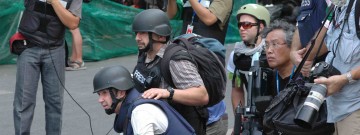Fabio Polenghi was killed by a burst of gunfire in Bangkok. Wounded in the lower abdomen, he was rushed to hospital on the back of a motor-scooter. The Italian freelance photographer had been in Thailand for three months on assignment for a European magazine and, like so many others, he was on the spot to cover the Thai military’s final push last Wednesday to retake a sprawling protest site in Bangkok’s retail heart.
Polenghi was the second to die while reporting on Thailand’s Red Shirt protesters. On April 10, Hiro Muramoto, a Japanese cameraman working for Reuters, was shot and killed when the Thai military tried to retake the first Red Shirt protesters’ encampment. A number of other journalists have been wounded covering the Red Shirt clashes, at least two seriously.
Journalism can be a dangerous profession. Military operations cost lives; and even impartial observers are not protected from stray bullets.
The Nine Network sent a crew led by a veteran to Bangkok to cover the Red Shirt clashes. Reporter Brett McLeod has covered the Iraq war, the 2006 war in Lebanon and attacks in Israel. Yet he concedes he and his crew bought flak jackets, from a disposal store in Bangkok, only the day before they needed them. “We came here in a hurry,” he says. “We had to scrounge around here to find them.” McLeod saw two people shot near him as the Thai troops advanced into the protest site, and after sheltering behind a hotel, he and his crew managed to escape the gunfire by using back alleyways.
He would never feel over-confident simply because he was fully equipped with protective gear, he says. “You don’t become impervious just because you have a flak jacket on”.
The members of one of the BBC crews covering the Red Shirt conflict, by way of contrast, were equipped not only with flak jackets and helmets, but with respirators, walkie-talkies and an attendant security adviser for much of the day.
Veteran cameraman and producer Darren Conway, better known as DC, has been to most of the world’s difficult places: Afghanistan, Iraq, Kosovo, Sudan, Congo, Lebanon and East Timor among them. Yet he is the first to say that regardless of all the equipment and the hostile environment training, a bullet can still kill you.
The equipment and the training, he says, simply give journalists a better chance of coming through battles in one piece.
Conway knows that clashes such as the Red Shirt fracas in Thailand over the past two months are extremely newsworthy, and he knows that many journalists have been attracted to the violence like moths to a flame.
He respects freelancers who try to tell a dangerous story without the support of big media organisations, but he says those larger firms should never send anyone to cover a clash who doesn’t have the correct equipment, and who hasn’t had the appropriate training.
“I think it’s wrong,” he says. “I think people are naive. I don’t have a problem with freelancers who want to get out there and tell a story and sell it. But to have an organisation that would allow their journalists to go in there without training and protection is completely wrong.”
Apart from other aspects of the training, he thinks first aid knowledge could be extremely useful. He was a friend of Muramoto’s, and he wonders whether the Japanese cameraman would have had a better chance of survival if he had been accompanied by another journalist, particularly someone fully trained in first aid.
Regardless of the exigencies of the situation, he says, the BBC would never ask a journalist or a cameraman to cover anything dangerous if they hadn’t had the appropriate training.
Hostile environment training is a reasonably new concept; few Australian news companies introduced it until the 90s, and of course it is constantly upgraded as weapons and tactics change.
On the other hand, many veterans have never had hostile environmental training, which has in many cases become an insurance requirement.
James Nachtwey, the renowned combat photographer who has been covering the Red Shirt fracas, apparently doesn’t wear a flak jacket, although he does wear a ballistic helmet.
Nirmal Ghosh, a past president of the Foreign Correspondents Club of Thailand and the Bangkok correspondent for The Straits Times, points out a full set of protective equipment can cost thousands of dollars, well beyond the means of most freelancers.
One of the factors that possibly makes matters more dangerous in Thailand, he says, is the willingness of the military and the police to allow journalists to go almost anywhere. There are no bans on covering operations, and on Wednesday journalists and television crews were seen running alongside troops, who appeared to be firing their weapons. “Thailand allows these guys to cover the story, which is fantastic,” Ghosh says, adding that the free access is often dangerous.
The legendary Australian cameraman, Neil Davis, was caught out by the unexpected when, in 1985, he covered an extremely brief coup attempt in Bangkok. After risking his life innumerable times in the war in Vietnam and Cambodia, Davis met his end in a Thai skirmish. He and his sound man, Bill Latch, were working for NBC and filming in front of a Thai army radio station when tanks opened fire at the building. Both were killed.
